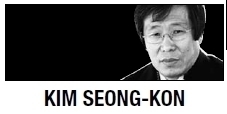[Kim Seong-kon] Raising the profile of Korean literature overseas
By KH디지털2Published : Sept. 29, 2015 - 17:20
Once again, the Nobel Prize season has come. Every year, we anxiously await the news that the Nobel Prize for literature is awarded to a Korean writer at last. And every year, we are disappointed.

How, then, could we raise the profile of Korean literature overseas? In order to achieve the goal, three things are imperative: great writers, good translators and big-name publishers. As someone who is in charge of translating and publishing Korean literature overseas, I am always on the lookout for a literary masterpiece that can represent Korean literature, a superb translator who can render the original work beautifully and an internationally well-known publisher that has connections with the press and influence on the book market. Of course, finding them is not an easy task.
As much as attractive literary works and famous publishers are important in promoting Korean literature overseas, my immediate concern is translation. Tracy Fisher from the WME Agency in U.S. recently pointed out, “For a Korean writer to break out into the English language market, a quality translator attached to the book early will be the key.”
Who, then, is an ideal translator? In the case of English translation of Korean literature, there has been a heated debate on who is the better qualified translator between an American or British translator and a Korean translator. Some people insist that American or British translators are much better than Korean translators because the latter are prone to make mistakes in grammar, syntax and wording, not to mention inadvertently using unstylish sentences and awkward expressions. Others strike back, insisting that Korean translators are better because British and American translators almost always make quite a few mistakes in their translation since they are often unable to comprehend Korean words or phrases and their cultural implications correctly.
In my experience, both arguments are right. Thus collaboration or cotranslation by two nationals can be a good solution. A prize-winning French translator, Jean-Noel Juttet, recently said, “In the case of translation into French, it is mostly occupied by pairs comprising a bilingual Korean who translates into French and a native speaker reviser who undertakes the stylistic checking and often much more than that.” But it is a time-consuming task because when two people are involved in translating a text, they need to spend long hours explaining and discussing the issues they encounter while translating.
An ideal translator, then, should be someone who is bilingual and bicultural. He should be either a native speaker of the target language who knows the original work and its cultural background quite well or a native speaker of Korean who can command impeccable, excellent English. Besides, he should have a keen literary sense and excellent writing skill. He also should love the literary work he wants to translate. In addition, he should have vast knowledge and profound understanding of Korean culture and society as well.
Generally, speaking, a Briton or American who can speak fluent Korean would be a more ideal translator of Korean literature than a Korean whose English proficiency is dubious. At the same time, however, it is noteworthy that some qualified Korean translators can be even better than sloppy but obstinate native speakers of English. John O’Brien, CEO of Dalkey Archive Press says, “The commonly held view that translations should be done only by those in the target language; my experiences in the past 30 years has been that some of Dalkey Archive’s best translations are done by native speakers with advanced skills in English.”
What made him say this? O’Brien continues: “They have a sense of meaning, tone and reference that oftentimes escapes the English-language translator, and that the editor is there to take care of or ask about the wording that has not quite made its way into English and will know when the right words are being used.”
So it all depends on who the translator is.
In his book, “Is That a Fish in Your Ear?,” David Bellow, too, argues that when reading a French detective story in English translation, it would be a bit funny to see the French people in the novel speak impeccable American English or slang. He points out that the reader would expect some French way of talking from them. His statement seems to acknowledge the merits of a French translator when translating a French literary work into English.
Aside from good translation, what do we need to bring Korean literature to a global readership? Tracy Fisher provides an idea, saying, “For Korean literature to become established in the U.S., it is my belief that the first wave will need to be in these particular and mainstream categories of suspense and mystery. Other types of Korean fiction can follow after inroads are made into the American market.” Indeed, we should produce literary works that would have strong international appeal. Once the door is open, more serious literature can follow
By Kim Seong-kon
Kim Seong-kon is a professor emeritus of English at Seoul National University and president of the Literature Translation Institute of Korea. -- Ed.


![[Exclusive] Korean military set to ban iPhones over 'security' concerns](http://res.heraldm.com/phpwas/restmb_idxmake.php?idx=644&simg=/content/image/2024/04/23/20240423050599_0.jpg&u=20240423183955)

![[Graphic News] 77% of young Koreans still financially dependent](http://res.heraldm.com/phpwas/restmb_idxmake.php?idx=644&simg=/content/image/2024/04/22/20240422050762_0.gif&u=)



![[Pressure points] Leggings in public: Fashion statement or social faux pas?](http://res.heraldm.com/phpwas/restmb_idxmake.php?idx=644&simg=/content/image/2024/04/23/20240423050669_0.jpg&u=)









